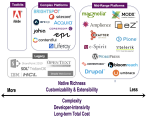What you can learn from the demise of Refresh Software
Every now and then a software company just up and dies. It doesn't happen often, and usually the tell-tale warning signs have been accumulating for years. As you the customer assess your current and potential crop of technology suppliers, it's worth reviewing autopsy reports for lessons learned.
The latest victim in the Web Content & Experience Management (WCXM) space is Refresh Software, who finally called it quits in recent months after a long period of, well, lack of refreshment.
Early in the last decade, Refresh Software made the now familiar transformation from web consulting company to software vendor, replete with outside funding and an imported "professional" CEO.
Refresh took a somewhat novel and useful approach to web content management: you could retrofit their content database and simple entry forms behind a pre-existing website or web application. This obviated the need to replace your entire front end when you implemented a CMS-based back end.
At a time when marketing managers were beginning to assume control of web publishing operations, few customers took to this approach -- Refresh became an explicitly techie sale -- but some enterprises saw value in such a highly decoupled architecture. Refresh customers who clearly understood what they were buying into seemed quite happy with the technology.
Alas, somehow Refresh lost their way. I can't offer any special inside dope on the company, but based on watching them in the marketplace over the years, I suspect their demise can be traced to three fundamental problems:
- Lack of implementation partners
Small- to mid-sized vendors can make a go of it with their own professional services consulting groups in lieu of a channel approach (Ektron is doing this now), but in the event, they need to make a real commitment there, since consulting is not a simple business to manage. Refresh never seemed to build up either a broad consulting channel or deep internal bench. - Permanent bootstrap mode
Although Refresh did acquire some outside funding, it continued to stay in loosely organized, start-up mode at a time when competitors were maturing their operations significantly. For example, product engineers at Refresh often did double-duty as support techs -- which was great for customers, sometimes -- but also meant that at other times both product release cycles and customer support could suffer. - Meandering roadmap
This was the killer, I suspect. Refresh initially committed to its simple, page-oriented approach -- pointing out correctly that not all web publishers need or could handle the overhead of highly structured, reuse-oriented systems. The company then did a complete about-face and wandered into the realm of "component document management," an area their technology (and likely most of their customers) were quite unsuited to support.
For better or worse, it takes more than good technology to succeed as a vendor. In fact, many outwardly successful WCXM vendors have sold rather poor technology (c.f., HP/Autonomy/Interwoven TeamSite). Operational acumen clearly matters, but so does building a sustainable community around any offering.
This is yet another reason why we pay increasing attention "vendor intangibles" in our comparative product evaluations, and you should too.
Best wishes to the former Refreshians as they move on to other firms.








